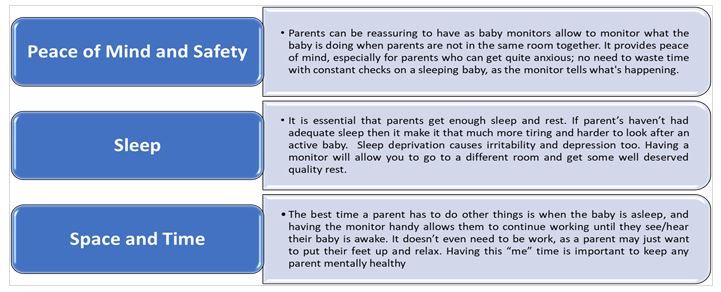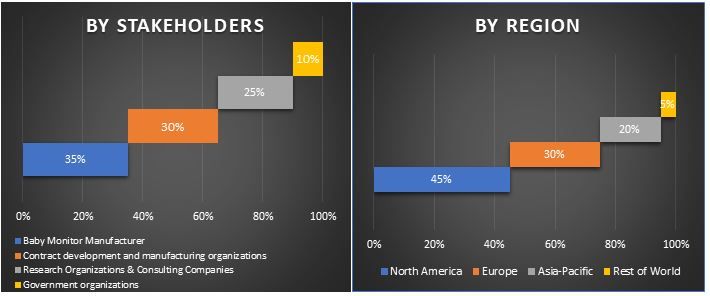- Home
- About Us
- Industry
- Services
- Reading
- Contact Us
Baby Monitor Market: Current Analysis and Forecast (2021-2027)
Emphasis on Product Type (Audio, Video); Connectivity (Wired, Wireless); Distribution Type (Retail stores, Supermarkets/Hypermarkets, E-Commerce, Specialty Stores); and Region & Country.

Promulgating awareness about child safety and emerging incidences of infant deaths globally is one of the key factors which is contributing to the growing demand for baby monitors. As per CDC, there are about 3,400 sudden unexpected infant deaths (SUID) in the United States Each year. Two major factors are responsible for the SUID incidences. The factors are Sudden infant death syndrome (37.0%), Accidental suffocation, and strangulation in bed (28.3%). The incidence of suffocation and strangulation in bed increased from 15.8 deaths per 1,00,000 births in 2015 to 25.5 deaths per 1,00,000 births in 2019. Also, a surge in the e-commerce sector adding pace to the growing market. According to UNCTAD, the e-commerce sector saw a “dramatic” rise in its share of all retail sales, from 16% in 2019 to 19% in 2020.
Moreover, the Proliferating number of working parents coupled with a rise in nuclear families globally is a leading cause that is adding pace to the growth in the demand for baby monitors. As per the Bureau of Labor Statistics, Among married-couple families with children, 95.3% had at least one employed parent in 2020, and 59.8% had both parents employed. Furthermore, a surge in the end user’s disposable income is a factor that is contributing to the growing market of baby monitors, globally. As per OCED, the household spending in Canada, China, Denmark, European Union, France and Germany reached to US$ 1,021,459.5, 9,241,095.5, 139,229.8, 10,785,281.3, 1,561,879.9 and 2,288,541.1 million respectively.
Also, the COVID-19 pandemic has pushed the demand for baby monitors globally. Hospitals, other healthcare facilities, and home healthcare facilities are using baby monitors for remote monitoring of patients as baby Monitors are helping patients to connect with doctors and family members through the COVID-19 situation. Philips has donated 3,200 baby monitors in collaboration with the online shopping site, bol.com. These are being sent to hospitals where they’re used to communicate with COVID-19 patients
Imports Reasons for Parents to Have a Baby Monitors

Samsung Electronics, Dorel Industries Inc., Summer Infant Inc, Koninklijke Philips N.V., Lenovo Group Limited (Motorola), VTech Communications, Inc., Arlo Technologies Inc., Panasonic Corp, Sony Corporation, Snuza International, etc., are some of the prominent players operating in the global Baby Monitor market. Several M&As along with partnerships have been undertaken by these players to facilitate customers with hi-tech and innovative products.
Insights Presented in the Report
“Amongst Product Type, Video segment holds the major share”
Based on the product type, the market is fragmented into Audio and Video. The Video segment dominated the market with a share of 86.4% in 2020 and is expected to maintain its dominance during the forecast period owing to the innovation in the video baby monitors by the companies. For instance: Infant Optics, a leader in the development and manufacturing of high-quality baby monitors, has launched its latest product addition, the new DXR-8 PRO video baby monitor in 2020.
“Amongst Connectivity Type, Wireless segment dominated the market during the forecast period”
Based on connectivity type, the market is mainly fragmented into Wired and Wireless. In 2020, the Wireless segment accounted for a maximum market revenue share of 62.4% and is expected to remain dominant during the analyzed period.
“Amongst Distribution Type, Retail Stores segment dominated the market during the forecast period”
Based on Distribution Type, the market is mainly fragmented into Retail stores, Supermarkets/Hypermarkets, E-Commerce, and Specialty Stores. In 2020, the Retail store grabbed the major market share and dominated the market. The segment gathered a 36.7% revenue share.
“North America represents one of the largest markets of Baby Monitor market”
For a better understanding of the market dynamics of the Baby Monitor market, a detailed analysis was conducted for different regions across the globe including North America (the U.S, Canada, and the Rest of North America), Europe (Germany, France, Spain, United Kingdom, Italy, and Rest of Europe), Asia-Pacific (China, Japan, India, Australia, South-Korea, and Rest of APAC), Rest of World. North America dominated the market and generated revenue of US$ 476.9 million in 2020 owing to the rising per capita income. As per the World Bank, GDP per capita income in the United States increased from US$ 56,839.38 in 2015 to US$ 65,297.51 in 2019.
Reasons to buy this report:
- The study includes market sizing and forecasting analysis validated by authenticated key industry experts
- The report presents a quick review of overall industry performance at one glance
- The report covers an in-depth analysis of prominent industry peers with a primary focus on key business financials, product portfolio, expansion strategies, and recent developments
- Detailed examination of drivers, restraints, key trends, and opportunities prevailing in the industry
- The study comprehensively covers the market across different segments
- Deep dive regional level analysis of the industry
Customization Options:
Baby Monitor Market can further be customized as per the requirement or any other market segment. Besides this, UMI understands that you may have your own business needs, hence feel free to connect with us to get a report that completely suits your requirements.
Table of Content
Analyzing the historical market, estimation of the current market, and forecasting the future market of the Global Baby Monitor Market were the three major steps undertaken to create and analyze the adoption of Baby Monitor for the different diseases across major regions globally. Exhaustive secondary research was conducted to collect the historical market numbers and estimate the current market size. Secondly, to validate these insights, numerous findings and assumptions were taken into consideration. Moreover, exhaustive primary interviews were also conducted, with industry experts across the value chain of the Baby Monitor sector. Post assumption and validation of market numbers through primary interviews, we employed a top-down/bottom-up approach to forecast the complete market size. Thereafter, market breakdown and data triangulation methods were adopted to estimate and analyze the market size of segments and sub-segments the industry pertains to. Detailed methodology is explained below:
Analysis of Historical Market Size
Step 1: In-Depth Study of Secondary Sources:
Detailed secondary study was conducted to obtain the historical market size of the Baby Monitor through company internal sources such as annual report & financial statements, performance presentations, press releases, etc., and external sources including journals, news & articles, government publications, competitor publications, sector reports, third-party database, and other credible publications.
Step 2: Market Segmentation:
After obtaining the historical market size of the Baby Monitor market, we conducted a detailed secondary analysis to gather historical market insights and share for segments and sub-segments for major regions. Major segments included in the report are product type, connectivity, distribution channel, and regions. Further country-level analyses were conducted to evaluate the overall adoption of Baby Monitor in that region.
Step 3: Factor Analysis:
After acquiring the historical market size of different segments and sub-segments, we conducted a detailed factor analysis to estimate the current market size of the baby monitor. Further, we conducted factor analysis using dependent and independent variables such as the mounting purchasing power and household disposable income, growing awareness of newborn deaths, illnesses, and baby safety, an emerging number of nuclear families and working parents, etc. A thorough analysis was conducted for demand and supply-side scenarios considering top partnerships, merger and acquisition, business expansion, and product launches in the Baby Monitor industry across the globe.
Current Market Size Estimate & Forecast
Current Market Sizing: Based on actionable insights from the above 3 steps, we arrived at the current market size, key players in the Baby Monitor market, and market shares of the segments. All the required percentage shares split, and market breakdowns were determined using the above-mentioned secondary approach and were verified through primary interviews.
Estimation & Forecasting: For market estimation and forecast, weightage was assigned to different factors including drivers & trends, restraints, and opportunities available for the stakeholders. After analyzing these factors, relevant forecasting techniques i.e. top-down/bottom-up approach was applied to arrive at the market forecast about 2027 for different segments and subsegments across the major markets globally. The research methodology adopted to estimate the market size encompasses:
- The industry’s market size, in terms of value (US$) and the adoption rate of Baby Monitor across the major markets domestically
- All percentage shares, splits, and breakdowns of market segments and sub-segments
- Key players in the Baby Monitor market in terms of services offered. Also, the growth strategies adopted by these players to compete in the fast-growing market
Market Size and Share Validation
Primary Research: In-depth interviews were conducted with the Key Opinion Leaders (KOLs) including Top Level Executives (CXO/VPs, Sales Head, Marketing Head, Operational Head, and Regional Head, Country Head, etc.) across major regions. Primary research findings were then summarized, and statistical analysis was performed to prove the stated hypothesis. Inputs from primary research were consolidated with secondary findings, hence turning information into actionable insights.
Split of Primary Participants in Different Regions
Market Engineering
Data triangulation technique was employed to complete the overall market estimation and to arrive at precise statistical numbers of each segment and sub-segment of the Baby Monitor market. Data was split into several segments & sub-segments post studying various parameters and trends in the areas of vehicle type and applications of the Baby Monitor market.
Main Objective of the Baby Monitor Market Study
The current & future market trends of Baby Monitor were pinpointed in the study. Investors can gain strategic insights to base their discretion for investments from the qualitative and quantitative analysis performed in the study. Current and future market trends were determined the overall attractiveness of the market at a regional level, providing a platform for the industrial participant to exploit the untapped market to benefit as a first-mover advantage. Other quantitative goals of the studies include:
- Analyze the current and forecast market size of Baby Monitor in terms of value (US$). Also, analyze the current and forecast market size of different segments and sub-segments
- Segments in the study include areas of product type, connectivity, distribution channel, and regions
- Define and analysis of the regulatory framework for the Baby Monitor industry
- Analyze the value chain involved with the presence of various intermediaries, along with analyzing customer and competitor behaviors of the industry
- Analyze the current and forecast market size of the Baby Monitor market for the major region
- Major regions studied in the report include North America (the U.S and Canada), Europe (Germany, France, U.K Spain, and Italy), Asia-Pacific (China, Japan, Australia, South-Korea, and India), Rest of the World
- Company profiles of the Baby Monitor market and the growth strategies adopted by the market players to sustain in the fast-growing market
- Deep dive regional level analysis of the industry
Related Reports
Customers who bought this item also bought











